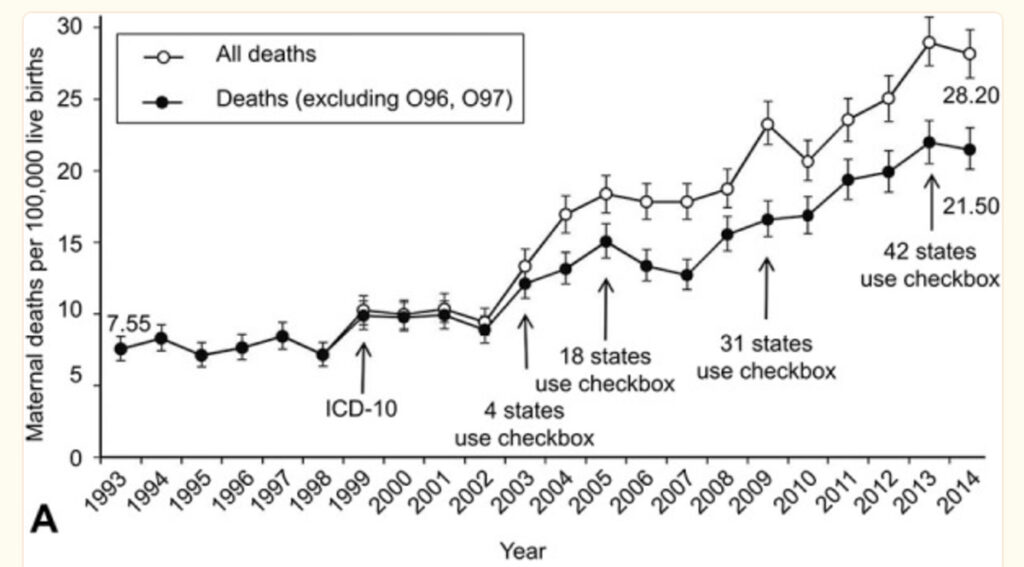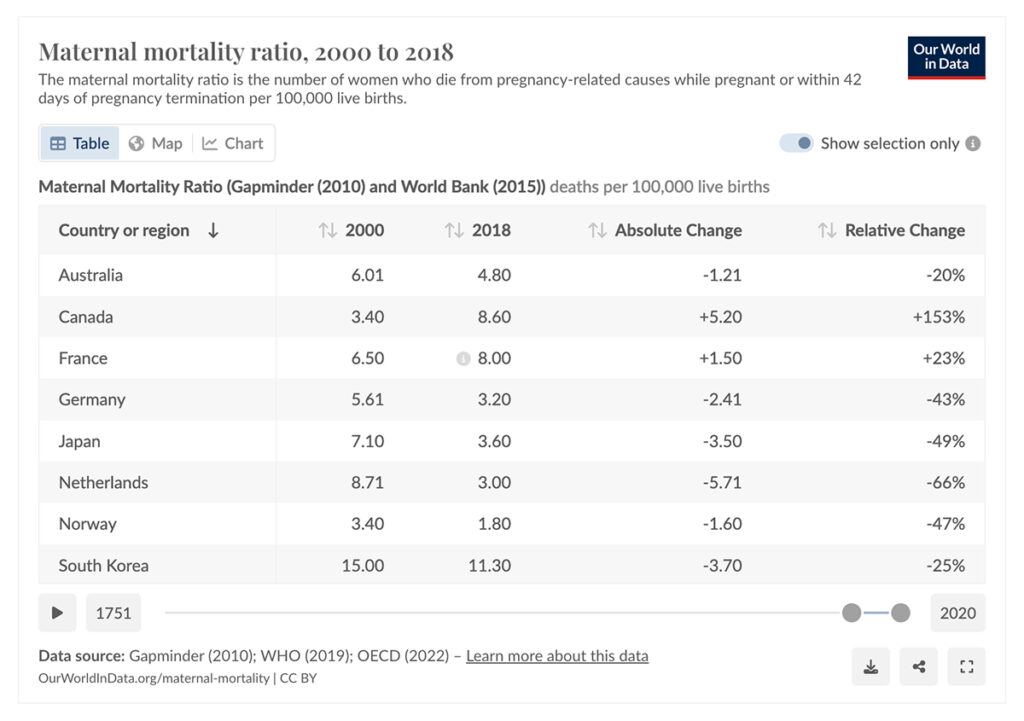Volcanoes are erupting in The Philippines, but on-fire Australia received some welcome rain. The Iran war cries have been called off and The Donald’s military powers are about to be hamstrung by the Senate. Meanwhile, his impeachment trial is starting, and we’re all on Twitter for a front-row seat.
What Could Go Right? When the culprit is data
Is the alarm over maternal mortality rates in the US warranted?
This is our weekly newsletter, What Could Go Right? Sign up here to receive it in your inbox every Thursday at 5am ET. You can read past issues here.
When the culprit is data
“Maternal mortality soars in America.” “US maternal mortality rates have almost doubled in the last two decades.” “Alarming rise in US maternal mortality signals need for change.”
This sampling of recent headlines fits nicely with the popular impression that the United States is a failing country with health outcomes that lag behind its peers.
But is the data underlying these headlines accurate?
In November I wrote about the worldwide decline of child mortality rates and as part of that research looked at the Centers for Disease Control and Prevention’s (CDC) data on pregnancy-related mortality in the US. On that page, the CDC writes that pregnancy-related deaths have risen since 1987, when a surveillance system for them was put into place. They also add that there are questions around how the data is collected, “potentially leading to overestimation of the number of pregnancy-related deaths.”
That raised an eyebrow. I’m no public health expert, but it seemed odd that a nation with a 22 percent decline in infant mortality between 2002 and 2021 had simultaneously worsened outcomes for mothers so badly. Add in the CDC’s data caveat, and I was officially on the lookout for an explanation.
I was delivered one this week via the economist Noah Smith’s Substack, where he highlighted a 2021 study of an investigation by The National Center for Health Statistics (NCHS), a unit of the CDC, that seems to have slipped under the media’s radar. The authors write:
“ . . . detailed reports by the [NCHS] . . . showed that there had been no temporal increase in overall maternal death rates in the United States. The rising trend in maternal mortality rates was entirely an artifact of changes in maternal death surveillance.”
How come everyone says otherwise, then?
A pregnancy checkbox was introduced onto death certificates in 2003 and picked up by states at different times. The checkbox caught some previously missed cases. But it also led to a progressive increase in recorded maternal deaths for causes labeled as a generic “other,” whereas specific causes like anesthesia complications, preeclampsia, blood clots, and so on showed significant declines.

NCHS re-crunched the numbers without including the pregnancy checkbox and found that between 2000 and 2018, age-adjusted maternal mortality rates declined by 21 percent.
That puts the US rate at 8.7 per 100,000 live births in 2018, so in the company of Canada and France, but lagging behind Germany, Japan, the Netherlands, and others. From an absolute numbers standpoint, this is under 1,000 deaths every year.

The authors take care to say that there is plenty that the US can improve upon. Racial disparities did not magically disappear, for instance, with maternal mortality rates 2.5 times higher among black women than white (and lowest among Hispanic women). And I would guess that rates, pregnancy checkbox or no, increased during the pandemic years.
But it does complicate the overall picture of a nation failing its expectant mothers. Changing the way that data is collected is a different story than deteriorating obstetric care.
Homelessness: a (bad) update
Last month I wrote that homelessness had not spiked in the US, comparing numbers from 2007, when reporting began (647,258 total homeless) with 2022 (582,462). It was the end of the year, and I should have known not to write about data that was about to be updated.
The 2023 data is now out, and homelessness has definitely spiked. We have regressed, surpassing 2007’s count with 653,100 total homeless in 2023.
Axios has the breakdown here. My apologies for the poorly timed piece, and now for the bad update.
Quick hits
- Cape Verde became the third African country to be declared free of malaria, which means that there haven’t been any local cases of transmission for three years. It’s the first sub-Saharan country to be given the status in 50 years.
- The Food and Drug Administration (FDA) has recommended reclassifying marijuana as a Schedule III substance. It has been classified as Schedule I since the 1970s, along with heroin, LSD, and ecstasy—drugs with a high abuse risk and no medical use. A new classification could have several downstream effects for state tax and criminal codes. The Drug Enforcement Association (DEA) will have the final say.
Below in the links section, volcano power, portable X-ray machines, AI-boosted research, and more.

What Could Go Right? S5 E14

What’s really happening on college campuses? Is free expression on them dead, or have we reached peak cancel culture? And why have younger generations completely abandoned the principles behind free speech? Today, we’re joined by attorney Greg Lukianoff, the President and CEO of the Foundation for Individual Rights and Expression (FIRE), who shares his perspective and his hopes for the role of free speech defenders and alternative approaches to higher education. | Listen to the episode
Progress, Please
(Found good news? Tweet at us @progressntwrk or email.)
Other good stuff in the news 🌋
Energy & Environment:
- World’s renewable energy capacity grew at record pace in 2023 | The Guardian
- US carbon emissions fell in 2023 as coal use tumbled to new lows | The New York Times
- Iceland will tunnel into a volcano to tap into virtually unlimited geothermal power | ZME Science
- Poland to halt logging in 10 of its most ancient forests | The Guardian
- Amazon rainforest: Deforestation rate halved in 2023 | BBC
Public Health:
- Groundbreaking procedure allows heart repairs to grow with children, new study shows | CNN
- How portable X-ray machines are helping remote patients | BBC
- We finally know the cause of severe morning sickness. A remedy could be next | National Geographic
- Yaws could soon be eradicated—70 years behind schedule | Nature
Science & Tech:
- AI copilots and robo-labs turbocharge research | Axios
- New material found by AI could reduce lithium use in batteries | BBC
- These architects want to save birds from the buildings that kill them | The Guardian
Politics & Policy:
- UK sets out plans for ‘biggest nuclear power expansion in 70 years’ | The Guardian
- Greece’s government set to legalize same-sex marriage with the backing of the opposition | Euronews
- Electric school buses are a breath of fresh air for children | Grist
- A California city’s transformation from ‘murder capital’ of the US to zero homicides | Los Angeles Times
- School lunches are Brazil’s secret weapon in halting hunger | NPR
Economy:
- Gasoline is cheap right now—but charging an EV is still cheaper | Yale Climate Connections
- Long-run decline in US poverty continued in recent years despite pandemic, new report shows | Notre Dame News
- IRS says it collected $360 million more from rich tax cheats as its funding is threatened yet again | AP
- Fresh inflation data shows intact, but bumpy, cool-down | The New York Times
TPN Member originals 🧠
(Who are our Members? Get to know them.)
- Kierkegaard’s three ways to live more fully | Arthur C. Brooks
- Rob Henderson on foster care, social class and the new American elite | Yascha Mounk
- ‘For All Mankind‘ is still the pro-progress, Up Wing show Hollywood and America needs | James Pethokoukis
Department of Ideas 💡
(A staff recommendation guaranteed to give your brain some food for thought.)
Why our fear of cancer is outdated—and harmful | The Washington Post
Why we picked it: “The public is mostly unaware of the quiet, incremental progress that has made so many cancers treatable or curable,” David Ropeik writes. “Very few know that many common cancers never kill.” Can we update our fear of it to be more aligned with the facts? —Emma Varvaloucas
Until Next Time
Evergreen thoughts on the art of perspective. 🕰️ 🔍


